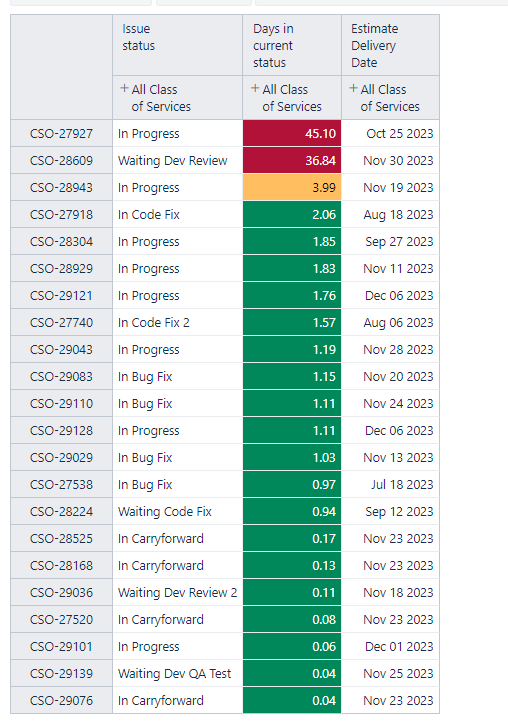Hi all, I want to automatically calculate estimated dates for delivering tickets based on cycle dates from the previous months
So I have created the following report
The estimated delivery date that I am calculating uses the following calculation:
CASE WHEN
[Measures].[Issue status]="Raised" OR [Measures].[Issue status]="Reopened" OR [Measures].[Issue status]="PENDING" OR [Measures].[Issue status]="Blocked"THEN
DateAddDays("today",Int([Measures].[Days in transition status]))
ELSE
CASE WHEN [Measures].[Issue status]="In Progress" OR [Measures].[Issue status]="On Hold" THEN
DateAddDays("today",13 - Int([Measures].[Days in transition status]))
ELSE
CASE WHEN
[Measures].[Issue status]="Waiting Dev Review" or [Measures].[Issue status]="Dev Reviewing" or [Measures].[Issue status]="Waiting Code Fix" or [Measures].[Issue status]="In Code Fix" or [Measures].[Issue status]="Waiting Dev Review 2" or [Measures].[Issue status]="In Dev Review 2" or[Measures].[Issue status]="Waiting Code Fix 2" or [Measures].[Issue status]="In Code Fix 2"
THEN
DateAddDays("today",7-Int([Measures].[Days in transition status]))
ELSE
CASE WHEN
[Measures].[Issue status]="Generating Bundle" OR
[Measures].[Issue status]="Waiting Bundle"
THEN
DateAddDays("today",3-Int([Measures].[Days in transition status]))
ELSE
CASE WHEN
[Measures].[Issue status]="Waiting Dev QA Test" OR
[Measures].[Issue status]="In Test" OR
[Measures].[Issue status]="Waiting Bug Fix" OR
[Measures].[Issue status]="In Bug Fix" OR
[Measures].[Issue status]="In Reopened Fix"
THEN
DateAddDays("today",2-Int([Measures].[Days in transition status]))
ELSE
DateAddDays("today",0)
END
END
END
END
END
Now, instead of using in this calculation the constant values, for example, in this case:
> CASE WHEN
> [Measures].[Issue status]="Generating Bundle" OR
> [Measures].[Issue status]="Waiting Bundle"
> THEN
> DateAddDays("today",**3**-Int([Measures].[Days in transition])
The constant from this case is 3 because I have a table with all the cycle times, so I manually get the int as the picture shows, which is the Average Bundle Cycle Time from the last month.
Now, instead of having to input this number automatically, I would like to replace the constant using a calculation , I would have something like this
> CASE WHEN
> [Measures].[Issue status]="Generating Bundle" OR
> [Measures].[Issue status]="Waiting Bundle"
> THEN
> DateAddDays("today",int([Measures].[AVG Bundle Cycle Time month ago]-Int([Measures].[Days in transition])
The problem is that I cannot do it this, because the row for this table are tickets that are not resolved, and all my cycle calculations uses resolved (on Bundle Cycle Time , for instance, is
Aggregate
(
{[Measures].[Waiting Bundle days of resolved issues], [Measures].[Generating Bundle days of resolved issues], [Measures].[Waiting Dev QA test days of resolved issues], [Measures].[In Test days of resolved issues], [Measures].[Waiting Bug fix days of resolved issues], [Measures].[In bug fix days of resolved issues] } )/[Measures].[Issues resolved]
Can you help me with this?
